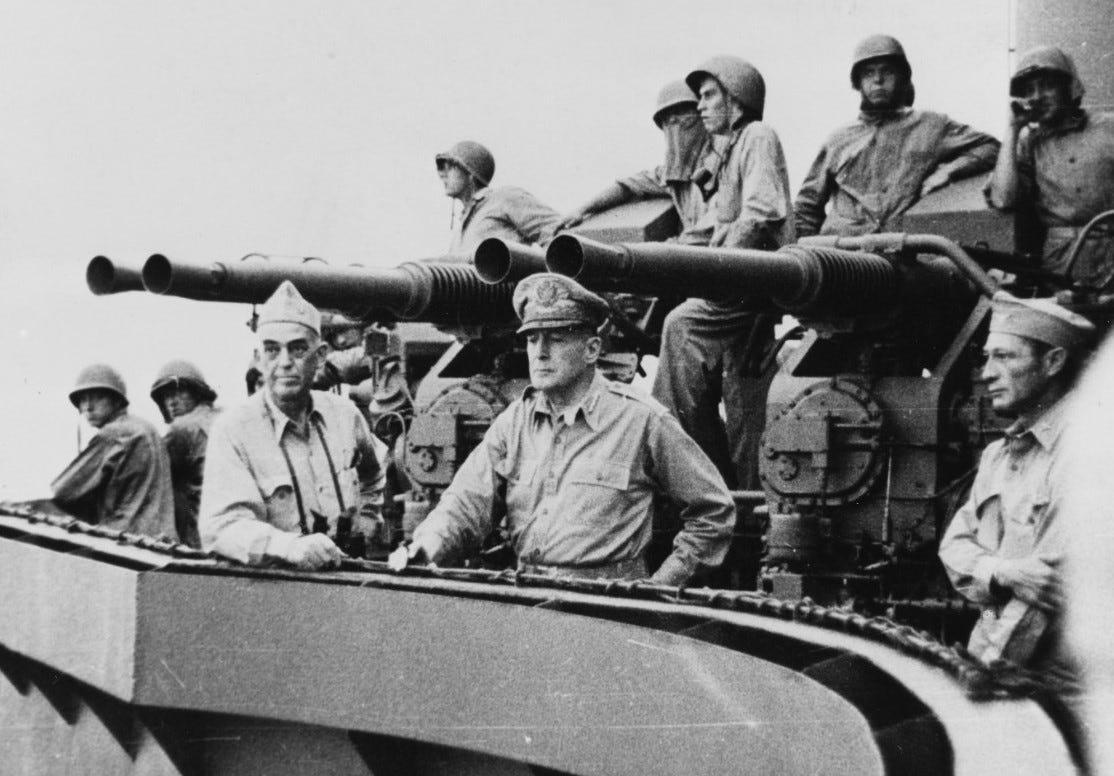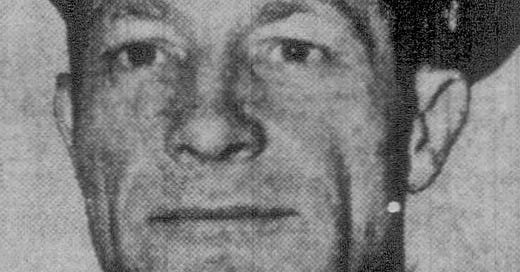Lloyd Lehrbas, from Warsaw correspondent to MacArthur aide
Just after 5:30 p.m. local time on Sept. 1, 1939, Associated Press correspondent Lloyd Lehrbas began dictating the story of ongoing German air raids on Warsaw to a colleague in Hungary.
The AP put the story on the wire as-is, making it read like a transcript of a radio report:
I am telephoning this dispatch to Budapest with the phone in one hand and a gas mask in the other.
From where I am, I can hear the wail of power-diving fighting ships and can see 14 German bombers slowly, steadily following the course of the Vistula River, Poland’s outlet to the sea. Apparently, they are attempting to destroy all the bridges.
The raid began at about 4:30 p.m. and is still continuing more than an hour later. … Although the raid is still on, there is no panic.
Across the street from me, hundreds of inhabitants are watching fascinated on roof tops. Tremendous explosions are shaking the city and rattling windows.
Anti-aircraft shells are bursting around the bombers which are coming over at an altitude of about 6,000 feet. Warsaw had little warning.
That last sentence notwithstanding, everyone knew things could get bad there in a hurry as relations between Poland and Germany deteriorated in a hurry that summer. Which is one of the reasons Lehrbas was there.
As one of the AP’s most well-traveled, battle-tested correspondents, he had exactly the kind of skill set needed to report from a hotspot like Warsaw, and his presence paid off on the first day of a global conflict that would rage for the next six years.
Lehrbas would have a role to play throughout, first as a correspondent and later as a top aide to Gen. Douglas MacArthur — a journalist-to-government-official transition he would repeat after the war.
Lloyd Lehrbas, who went by Larry, was born Oct. 15, 1896 in Montpelier, Idaho. He grew up there and in Boise and attended the University of Idaho and the University of Wisconsin but left the latter to join the Army Air Service when the U.S. entered World War I.
He already had his start in journalism by then, working as a correspondent for the Salt Lake Tribune while in college, and his first job after being discharged was with the San Francisco Chronicle. He spent four months in the Far East and Russia in mid-1919 writing stories for the Chronicle and Chicago Tribune.
In 1921, he traveled to the Philippines and had a short stint with the Manila Daily Bulletin, then headed to Shanghai where he worked for the China Press for the next few years. He would return to the region several times in the decades to come.
Lehrbas went to work for Fox Movietone newsreels in the late 1920s, then did some public relations work in Washington, D.C., before joining the Associated Press staff there in December 1933.
When fighting broke out between China and Japan in mid-1937, Lehrbas’ background made him a natural fit to cover the conflict. That September, he sailed to China and covered the war from Shanghai for the next year and a half.
In April 1939 Lehrbas flew from Hong Kong to Rome — a journey that took six days to complete — as the AP moved resources into place to cover what it called the “war of nerves” ongoing in Europe.
Once the shooting began, Lehrbas remained in Warsaw as long as he could before moving on to Lwow in a creaky old German car as Nazi troops closed in on the capital.
From there he moved on to Budapest and then Bucharest, where on Sept. 21 he scooped the world with news of the assassination of Prime Minister Armand Calinescu by calling pieces of the story in to five different AP bureaus — Rome, Copenhagen, Budapest, Bern and Amsterdam — as Romanian officials tried to keep the information from getting out of the country immediately.
Lehrbas reported from Turkey and Greece before returning to the U.S. on Dec. 12, 1939. He went right back to work in Washington before sailing back to Italy exactly five months later for a new assignment as a roving correspondent in Europe.
He was back in the U.S. by the fall of 1940 and spent the next year or so covering the State Department. In that role, he filed a story on Dec. 6, 1941 that began:
An uneasy peace hung over the Pacific Saturday as the United States waited for Japan to make its choice between conciliation or further attempts at conquest in the Far East.
The choice, of course, had already been made, and once the United States entered the war after the attack on Pearl Harbor, Lehrbas wanted to serve directly.

He took a leave of absence from the AP and in February 1942 was commissioned as a lieutenant colonel, joining MacArthur’s staff in Australia the following month. He was promoted to full colonel on Sept. 1, the three-year anniversary of his phoned-in report from Warsaw.
Later that month, Lehrbas would send home news of his former AP colleague Vern Haugland, who was hospitalized in Port Moresby after surviving a 43-day ordeal in the jungles of New Guinea.
Lehrbas continued to serve alongside MacArthur in the coming years, including a visible part in the general’s return to Luzon in January 1945. In Carl Mydans’ famous photo of MacArthur wading ashore at Lingayen Gulf, Lehrbas is the man behind the general, wearing a helmet and sunglasses.
Returning to the U.S. after the war, Lehrbas in 1946 became executive editor of a new magazine called World Report, a companion to the existing United States News (the titles would merge in 1948).
In May of 1948, Lehrbas joined the State Department and among other duties took oversight of Voice of America. He eventually moved to the Pentagon, where he served as a public relations adviser to secretaries of the Army and Army chiefs of staff including Gen. Matthew Ridgway and Gen. Maxwell Taylor.
Lehrbas left Washington in October 1964 to return home to Idaho. Battling emphysema, he entered the Veterans Administration hospital in Boise on the 26th and died four days later. He was 68 years old.




